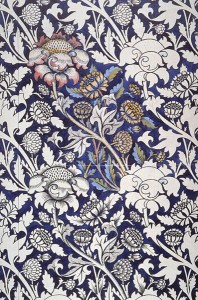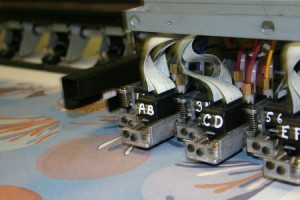Career in Textile Designing
 The textile sector in India is like that huge billboard at the signal you just cannot ignore. It not only provides for one of the most basic physiological needs of the people in the country, but is also responsible for enormous economic development. According to the Government of India’s website -it is one of the most capital and labour intensive industry that contributes four per cent to the country’s GDP and 13.5 per cent to the annual export earnings; it is the second largest employer after the agricultural sector, employing 35 million people directly. This, further supported by India’s rich and varied heritage of textiles, makes a career in textile design an exciting proposition.
The textile sector in India is like that huge billboard at the signal you just cannot ignore. It not only provides for one of the most basic physiological needs of the people in the country, but is also responsible for enormous economic development. According to the Government of India’s website -it is one of the most capital and labour intensive industry that contributes four per cent to the country’s GDP and 13.5 per cent to the annual export earnings; it is the second largest employer after the agricultural sector, employing 35 million people directly. This, further supported by India’s rich and varied heritage of textiles, makes a career in textile design an exciting proposition.
Textile Design forms the core of the whole business of fashion. The rapidly expanding activities in the export and domestic sectors of the Indian apparel and home fashion industry demands professional inputs in design and development of textiles and raw material, which is responsible for 60-80% of the cost of the product. Textile design today is that strategic value adding activity that can make all the difference in transforming a fashion business into an economically viable and profitable proposition.
The Textile Design specialisation offered by Department of Fashion & Textiles equips students with broad-spectrum education in textiles while developing creativity, originality and design application in apparel and home fashion industries.
WHAT IS TEXTILE DESIGNING?
Any material or surface comprising fibers made by weaving, knitting, crocheting or pressing together fibers (felting) is called a textile. Different textiles can be created by altering any of these techniques or creating a new technique altogether. We change the surface of a textile by dyeing, printing, texturing or embroidering. A good course in textile design should mainly equip you with an understanding of all these areas so as to create a textile and also manipulate these techniques to create completely new textiles altogether.
Akkireddy Prakash, a student of National Institute of Design, Ahmedabad informs, “Textile designers need to understand fabrics and their behaviours and properties extremely well. They also need to possess a good sense of the visual and design principles like colour, composition, patterns, etc. Weaving forms a very important part of textiles. Apparently then, a course in textile designing includes a module that introduces students to various weaving methods so that they can experiment and create new weaves. This, because every weave delivers a different fabric.”
OPPORTUNITIES ABOUND
Careers
The programme prepares students for a wide range of careers in textile mills and export houses, with fashion designers, design studios, mills, buying houses, handloom cooperatives and buying agencies as Design or Fabric Managers, or work independently as Designers or Entrepreneurs.
Star Employers
Arvind Mills, Indian Terrain, Grasim Industries Ltd., Madura Brands, Mafatlal Industries Ltd., Nahar Industries, Shingora International, Ambadi Enterprises, Crew BOS, Himmatsingka Seide, Abhishek Industries, Welspun India, Shades of India, Linenscapes (India) Ltd., Textrade International Pvt. Ltd., Mura Collective, Portico, Creative Mobus Fabrics, Rateria Exports, Mahajan Overseas, Triburg, Bharat Silks, Third World Exports, The Shop, etc.
A textile designer can be employed in the garment, fashion, home furnishing and the interiors segment among other industries. Aneeth Arora, one of India’s emerging designers on the fashion scene, who has a textile education behind her says, “My textile background makes me feel like an artist weaving her own canvas before painting on it. Studying textiles has helped me understand the medium in totality. India has a tradition of rich arts and crafts that one can draw from. Each time I incorporate one textile technique in my work, I am introduced to two three newer ones to work with!”
The textile industry in India is evolving from the handloom, power loom and craft sectors to newer areas, like the paper and automobile industries. Dhanonjay Das, a textile designer employed at Reliance Industries’ Automotive Textile Division elaborates, “Automotive textile deals with the fabric used in car interiors. A car company, say a General Motors or Maruti, designs the interiors of a car keeping certain aesthetics in mind. The brief then goes to the automotive textile company which creates a fabric as per the client’s needs, for the seating of the car with the textile, and sends it to the car company. Automotive textiles need to be designed keeping the end use in mind – durability, comfort and visually appealing. Technological innovations play an extremely important role to suit the use. For example, these days water repellant fabrics are being developed for car interiors.”
QUINTESSENTIAL QUALITIES
The skill sets required to succeed in the textile field, be it the core industry or a high end design studio, are quite similar. Mala Sinha, owner of Bodhi, an ethnic wear lifestyle brand producing hand printed and handcrafted fabrics elaborates, in Vadodra, states, “While recruiting new designers, I look for someone who can work in a team, apart from obviously being equipped to handle prints, weaves, embroideries, who is well versed in design language, and has a thorough understanding of fabric. An equally important requirement for aspiring textile designers today is the need to be sensitive towards the environment and society.”
Keeping abreast with trends is also a part of the job requirement, as the textile industry caters to global markets. Harilein Sabarwal, a trend forecaster says, “Textile is one industry which religiously follows international forecast in terms of colour, prints, textures, etc. You will observe that if one shirting brand comes up with a particular colour, checks or stripes for a season, all shirting brands will come up with a similar stock. Indian companies also take part in textile fairs like Texworld in Paris so as to keep themselves updated with technology and innovation.”
Today, a host of degrees as well as diplomas are offered at the graduate and postgraduate level to equip you with these skills. However, an inclination towards design with a willingness to always be surrounded by loads of fabric is mandatory to make your mark in this industry.
MONEY MATTERS
Remuneration in the field ranges from the level you Vadodra,enter. For example if you want to start off in the fashion industry, working with a designer would call for an unpaid internship or assisting at a basic stipend. However, joining the industry as a fresher could pay you around 15-20 thousand per month up to even 30 thousand per month for students of prestigious institutes.
COURSE CUES
* National Institute of Design, Ahmedabad (www.nid.edu)
* National Institute of Fashion Technology, Bengaluru, Bhopal, Chennai, Gandhinagar, Hyderabad, Kangra, Kannur, Kolkata, Mumbai, New Delhi (www.nift.ac.in)
* Pearl, Delhi, Jaipur (www.pearlacademy.com)
* JJ School of Arts, Mumbai (www.jjsa.in)
* SOFT, Pune (www.softpune.com)
The textile sector in India is like that huge billboard at the signal you just cannot ignore. It not only provides for one of the most basic physiological needs of the people in the country, but is also responsible for enormous economic development. According to the Government of India’s website –www.india.gov.in – it is one of the most capital and labour intensive industry that contributes four per cent to the country’s GDP and 13.5 per cent to the annual export earnings; it is the second largest employer after the agricultural sector, employing 35 million people directly. This, further supported by India’s rich and varied heritage of textiles, makes a career in textile design an exciting proposition.
















